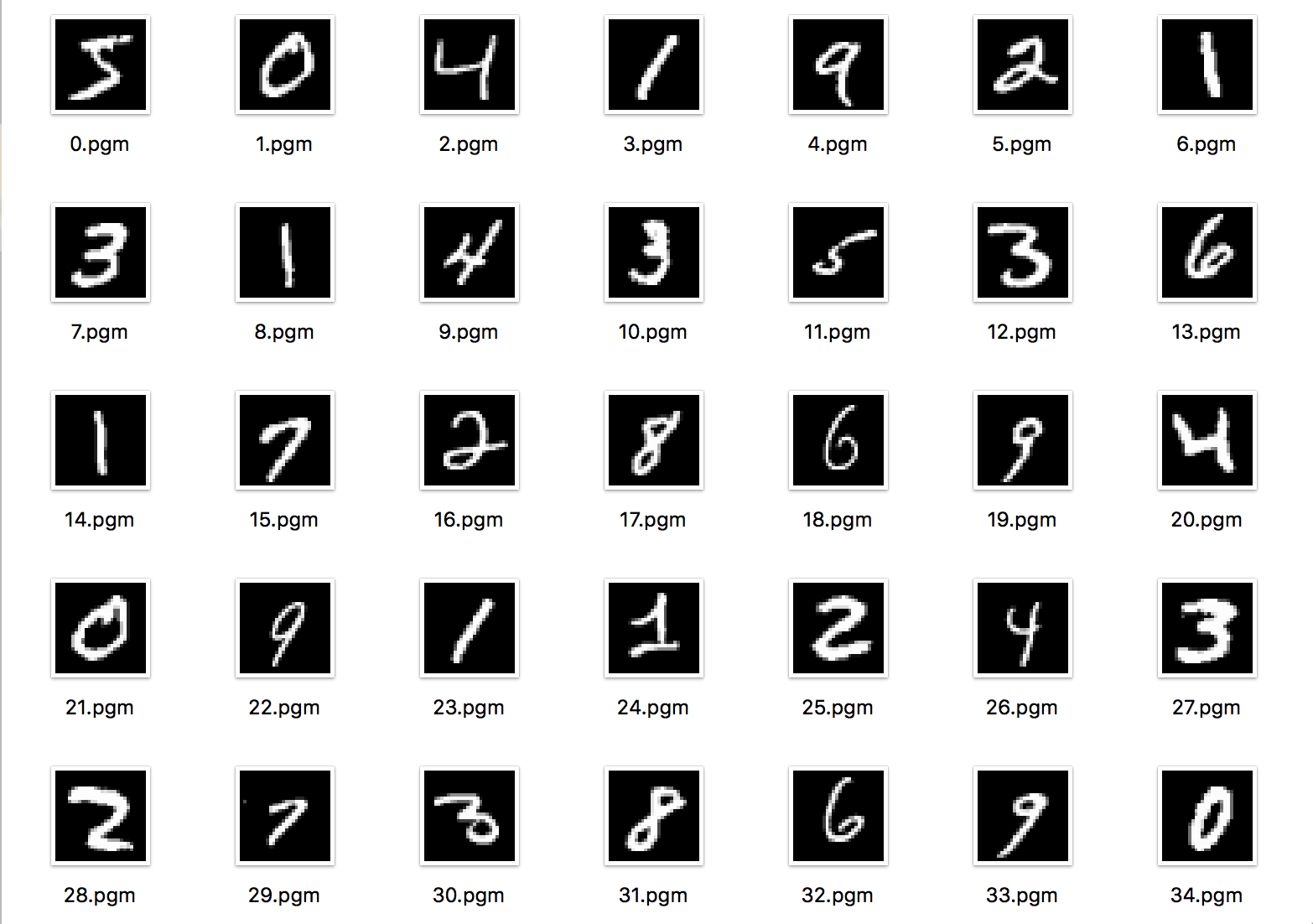基本のやつ、えむにすとやってみた。
手順
①MNISTデータのダウンロード
②MNISTのバイナリファイルをCSVに書き出し
③CSVデータを画像データに書き出して、ちゃんとCSVが書き出せているかを確認
④SVMで学習と評価
実行
①MNISTデータのダウンロード
MNISTデータはすでにtrain/test用のデータが分かれてgzファイルでダウンロードできます。
download.py
import os
from urllib.request import urlopen
def download(fname):
#MNISTファイルをサーバーから取得
print("%s downloading..." % fname)
with urlopen("http://yann.lecun.com/exdb/mnist/" + fname) as res:
d = res.read()
#mnistフォルダの下にデータを名前をつけて保存
with open("mnist/" + fname, "wb") as f:
f.write(d)
if __name__ == "__main__":
if not os.path.exists("mnist"):
os.mkdir("mnist")
download("train-images-idx3-ubyte.gz") #train画像ファイル
download("train-labels-idx1-ubyte.gz") #train正解ラベルファイル
download("t10k-images-idx3-ubyte.gz") #test画像ファイル
download("t10k-labels-idx1-ubyte.gz") #test正解ラベルファイル
②MNISTのバイナリファイルをCSVに書き出し
ダウンロードしたMNISTデータはgzipのバイナリファイルのため、学習させられるようにCSVデータにします。
prepare.py
import os
import gzip
import struct
def csv_image(fname, type_):
"""
画像データのCSV出力
fname : MNISTのファイル名
type_ : training / test
"""
# 画像データをGzipファイルから読み取る
#バイナリモードで読み込み
with gzip.open(os.path.join("mnist", fname), "rb") as f:
#">IIII":ビッグエンディアン(見た目通りの順番)で4バイトずつのパックで読み取り
#_ :はじめの4バイトはマジックナンバーが書かれている
#cnt:次の4バイトは画像の数
#row:次の4バイトは行の数
#cols:次の4バイトは列の数
_, cnt, rows, cols = struct.unpack(">IIII", f.read(16))
# 画像読み込み
images = []
for i in range(cnt):
binarys = f.read(rows * cols)
images.append(",".join([str(b) for b in binarys]))
# CSV結果として出力
with open(os.path.join("csv", type_ + "_image.csv"), "w") as f:
f.write("\n".join(images))
def csv_label(fname, type_):
"""
ラベルデータのCSV出力
fname : MNISTのファイル名
type_ : training / test
"""
# ラベルデータをGzipファイルから読み取り
with gzip.open(os.path.join("mnist", fname), "rb") as f:
_, cnt = struct.unpack(">II", f.read(8))
labels = []
for i in range(cnt):
label = str(struct.unpack("B", f.read(1))[0])
labels.append(label)
# CSV結果として出力します.
with open(os.path.join("csv", type_ + "_label.csv"), "w") as f:
f.write("\n".join(labels))
if __name__ == "__main__":
if not os.path.exists("csv"):
os.mkdir("csv")
# トレーニングデータ.
csv_image("train-images-idx3-ubyte.gz", "training")
csv_label("train-labels-idx1-ubyte.gz", "training")
# テストデータ.
csv_image("t10k-images-idx3-ubyte.gz", "test")
csv_label("t10k-labels-idx1-ubyte.gz", "test")
③CSVデータを画像データに書き出して、ちゃんとCSVが書き出せているかを確認
チェックチェック。
check.py
import os
CNT = 100 #100文字分だけ画像データ出力
if __name__ == "__main__":
if not os.path.exists("image"):
os.mkdir("image")
with open(os.path.join("csv", "training_image.csv")) as f:
images = f.read().split("\n")
for i, image in enumerate(images[:CNT]):
with open(os.path.join("image", "%d.pgm" % i), "w") as fw:
s = "P2 28 28 255\n" #P2(PGM形式記号), 28*28サイズ, 最終画像数をヘッダーとして書く
s += " ".join(image.split(","))
fw.write(s)
結果
④SVMで学習と評価
これまでは下準備。さて学習です。
svm.py
import os
from sklearn import svm, metrics
from sklearn.externals import joblib
# 学習用データの数
SIZE_TRAINING = 5000
# 検証用データの数
SIZE_TEST = 500
def load_data(type_, size):
"""
type_ : training / test
size : 返却する要素数
"""
#csvデータを改行してデータ数分区切っていく
with open(os.path.join("csv", "%s_image.csv" % type_)) as f:
images = f.read().split("\n")[:size]
with open(os.path.join("csv", "%s_label.csv" % type_)) as f:
labels = f.read().split("\n")[:size]
#各ピクセルに相当する数値(白黒:白0~黒255)を256で割って0-1の値に変換
images = [[int(i)/256 for i in image.split(",")] for image in images]
labels = [int(l) for l in labels]
return images, labels
if __name__ == "__main__":
# トレーニングデータを取得します.
images, labels = load_data("training", SIZE_TRAINING)
# 学習
print("学習開始")
clf = svm.SVC()
clf.fit(images, labels)
# テストデータを取得
images, labels = load_data("test", SIZE_TEST)
# 予測
print("予測開始")
predict = clf.predict(images)
# 結果表示
print("結果")
ac_score = metrics.accuracy_score(labels, predict)
cl_report = metrics.classification_report(labels, predict)
print("正解率 = ", ac_score)
print(cl_report)
# 結果を保存する
if not os.path.exists("result"):
os.mkdir("result")
joblib.dump(clf, os.path.join("result", "svm.pkl"))
結果
tonosakiyuni-no-MacBook:answer yuni$ python3 svm.py
学習開始
予測開始
結果
正解率 = 0.902
precision recall f1-score support
0 0.91 0.93 0.92 42
1 0.94 1.00 0.97 67
2 0.94 0.87 0.91 55
3 0.90 0.82 0.86 45
4 0.88 0.96 0.92 55
5 0.82 0.92 0.87 50
6 0.93 0.86 0.89 43
7 0.86 0.86 0.86 49
8 0.90 0.88 0.89 40
9 0.94 0.87 0.90 54
avg / total 0.90 0.90 0.90 500
90%でした。
precision と recall の平均が f1-score なので、ここを見るといいらしい。
「1」だけダントツいいね。「1」だけ...
学習する画像数を増やせば精度は上がるはず!
と思ったのでやってみた。
学習データ: 5000 → 30000
tonosakiyuni-no-MacBook:answer yuni$ python3 svm.py
学習開始
予測開始
結果
正解率 = 0.94
precision recall f1-score support
0 0.91 0.98 0.94 42
1 1.00 1.00 1.00 67
2 0.94 0.91 0.93 55
3 0.91 0.87 0.89 45
4 0.98 0.98 0.98 55
5 0.88 0.92 0.90 50
6 0.97 0.91 0.94 43
7 0.90 0.94 0.92 49
8 0.91 0.97 0.94 40
9 0.96 0.91 0.93 54
avg / total 0.94 0.94 0.94 500
94%でした。
もっと上がるとおもたのに。
やっぱり「1」だけいいね、「1」だけ。
今日はここまで、お疲れ様でした。
